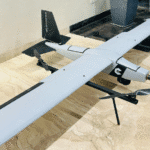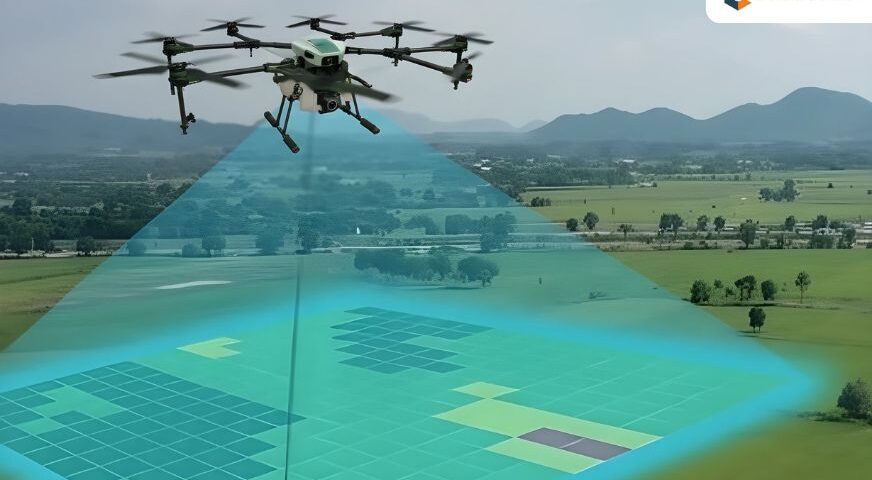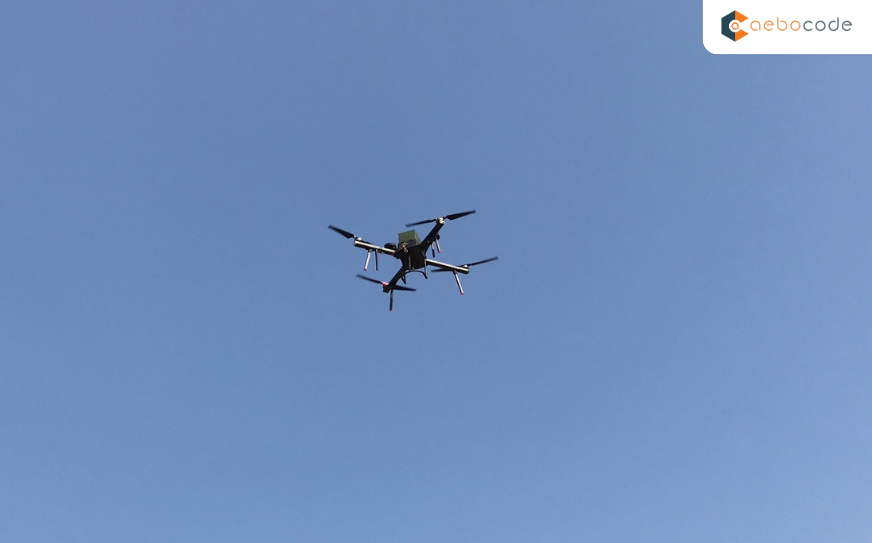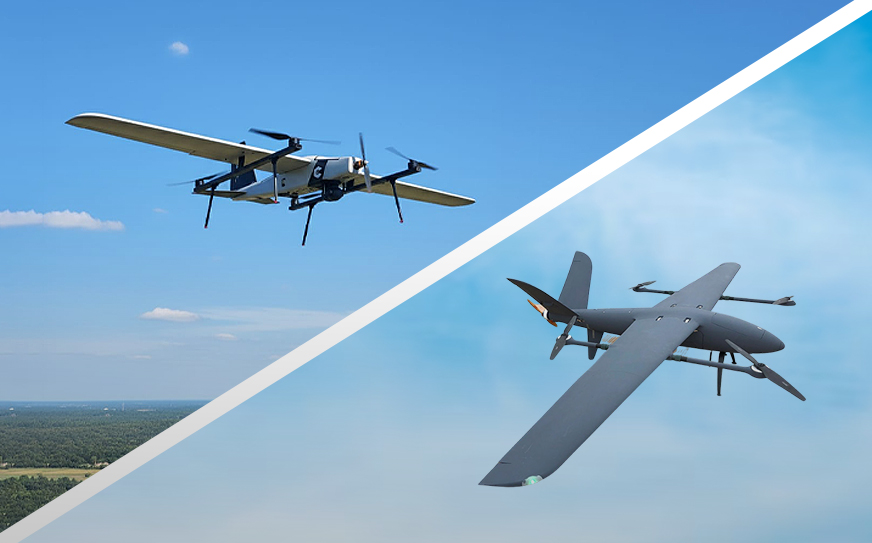
Made in India Drone Industries — An Industry Guide
September 20, 2025
Hybrid VTOL Drones in India: What the Future of Aviation and Technology Holds
September 30, 2025Mapping Drone Manufacturers: Guide to Airframes, Sensors and Mission Planning
Drones have transformed the way industries handle mapping and surveying. What once took days on the ground with heavy equipment can now be done in hours using a mapping drone. For fields like defense, agriculture, construction, and mining, drones bring high precision and cost-effective results. But with so many mapping drone manufacturers in the market, choosing the right system is not always simple. The decision often comes down to airframe type, sensor compatibility, mission planning, and regulations.
Airframe and drone models applied for mapping
There are multiple airframe models with mapping drones and they have all proven most suitable for a particular application:
Multirotor (quad/hex/octocopter): Very agile, can hover, and take high-accuracy vertical images. Suitable for small-area mapping, building structure surveying, and photogrammetry in close or complicated scenes (buildings, towers, mines). Shorter endurance (usually 20–45 minutes) but ideal for high-res low-altitude flights.
Fixed-wing: Appear as small airplanes and are known for high cruise speed and long endurance, and are best suited to large area mapping (tens of hundreds of square kilometers per mission). Require runway or catapult/hand-launch, and are better suited to orthomosaic generation and large survey work rather than vertical inspection.
VTOL (Vertical Takeoff and Landing fixed-wing hybrids): Provide VTOL convenience for takeoff/landing with fixed-wing range and efficiency. They’re expanding for mapping where operators need runway independence as well as increased coverage.
Hybrid and tethered systems: Hybrids come with deliberate compromises; tethered drones provide long endurance for fixed-site monitoring (e.g., extended surveillance or persistent coverage of a small area).
Also read : Defense Drone Manufacturers in India
Key Features of Mapping Drones
To compare mapping producers or mapping systems, the following technical and practical needs must be taken into account:
Endurance & range: For how long the UAV will remain airborne and how far it can go. This has a direct impact on mission planning and number of sorties needed.
Payload capacity & integration: Physical weight and interface available to accomodate hyperspectral modules, cameras, multispectral sensors, and LiDAR modules. Convenient standard payload bays and mounts (e.g., gimbal interfaces) make integration easy.
GNSS / RTK/ PPK support: High-location accuracy is critical. Onboard RTK (Real Time Kinematic) or PPK (Post Processed Kinematic) capability on drones significantly reduces ground control needs and optimizes georeferencing accuracy.
Sensor stabilisation & gimbals: Gimbal stabilisation has a direct impact on photogrammetric outputs and relies on flight stability and image clarity.
Autonomy and planning software: Mission planning ease, auto-mission assignment for waypoint missions, frontlap/sidelap, custom flight script or API support.
Pipeline & interoperability: Output data export formats (RAW, TIFF, JPEG, LAS for LiDAR), interoperation with photogrammetry and GIS applications (e.g., Pix4D, Agisoft Metashape, DroneDeploy, ArcGIS) and end-to-end workflow support.
Reliability & fault tolerance: Redundancy (two or more IMUs, two GNSS, power backup modules) reduces the risk of mission failure, especially in mission-critical mapping.
Environmental hardiness: IP ratings, aerodynamics, operating temperature range — all critical for outdoor use in harsh environments.
Maintainability & spare parts: Spare part availability, component modularity, and ease of maintenance reduce downtime.
Security & firmware transparency: For security or defense usage, highest priority to encrypted on-prem data and telemetry processing, secure comms are typically show-stoppers
Also read : Kids Drone Kits
Sensors and Payloads
The strength of a mapping drone lies in its payload.
- RGB cameras are the most common, used for standard orthomosaics and 3D models.
- Multispectral cameras record different bands of light, widely used in agriculture and environmental monitoring.
- LiDAR systems create accurate 3D terrain models and are valuable in forestry, infrastructure, and mining.
- Thermal sensors are increasingly used for energy audits, leak detection, and even search-and-rescue missions.
High-end mapping also relies on integrated GNSS and IMU modules for precise geolocation. The choice of payload depends entirely on the mission requirements.
Mission planning and data workflow fundamentals
A mapping flight is only as good as its procedure and planning:
Flight planning: Establish ahead of time altitude, speed, overlap, and flight lines. For photogrammetry, the standard overlap is 70–80% frontlap and 60–70% sidelap based on terrain and height.
Ground Control Points (GCPs): While RTK/PPK reduces the number of GCPs needed, setting up and verifying a set of sparsely located GCPs will add to absolute accuracy for most applications.
Data capture parameters: Image in RAW or high-level TIFF where practical; show consistent exposure and no motion blur. Calibrate and pre-plan scan angles for LiDAR flights.
Data processing: SfM and LiDAR processing workflows transform raw captures into orthomosaics, DEM/DTM, and classified point clouds. Coverage and sensor resolution increase processing time and computational demand.
Quality control: Perform georeferencing quality tests, mosaic seams, voids, and point cloud artifacts. Operators may need to retake flights or make adjustments to meet accuracy requirements.
Operational & regulatory considerations
Firms can deliver technologically advanced drones, but employment terms have to be fair.
Regulatory compliance: National regulations for aviation (UINs, licenses, BVLOS rules, height limits) apply to mapping operations. Some models are approved by some providers for some regions or compliance assistance.
Training & support: Training of operators, certification path, and technical support from the provider or local organizations are critical to safe, legal, and successful deployment.
Insurance & risk: Map operations may require third-party liability and equipment insurance.
Data sovereignty & security: defense or government operations may require raw data locally on servers; encrypted telemetry and closed or hybrid architecture enable this.
Also read : Kamikaze Drones
Platform choice: mission requirement alignment
Choosing a mapping drone manufacturer should begin with mission profiling:
Coverage rate per flight: multirotors map small city blocks; regional mapping is most effectively accomplished with fixed-wing or VTOL.
Accuracy requirement: Apply RTK/PPK to cadastral mapping or high-fidelity infrastructure and potentially LiDAR.
Payload versatility: You will be alternating between multispectral and LiDAR campaigns regularly, so utilize platforms with standardized payload mounts and sufficient payload range.
Operating climate: Robust platforms with proven field performance must handle tough operating environments such as wind, cold, or rain effectively.
Budget & lifecycle expenses: Don’t forget to add over acquisition cost: training, spares, software licenses, and maintenance.
Mapping drones are evolving quickly. Manufacturers are developing edge computing systems that process some data onboard, thereby reducing the need for transmission. Swarm operations — multiple drones working together — are becoming a reality, especially for large-scale projects. Sensor miniaturization is also improving efficiency, allowing drones to carry lighter, more powerful payloads.
Conclusion
Every mapping drone manufacturer brings different strengths in airframe design, sensor support, and autonomy. The best choice always depends on the mission: small-site mapping, regional surveys, high-accuracy cadastral projects, or specialized tasks like forestry and mining. Aebocode Technologies drone manufacturers map differently in terms of airframe configuration, sensor compatibility, autonomy, and availability. For the engineers and managers at Aebocode Technologies, the right choice is based on platform attributes that are appropriate for mission requirements: coverage requirements, accuracy requirements, payload versatility, operating conditions, and regulations. Through examination of endurance, GNSS precision, payload interfaces, streams of data, and integration opportunities, organizations can select platforms that not only support current projects as well as anticipated growth — without compromising safe, sound, and compliant mapping activity.






